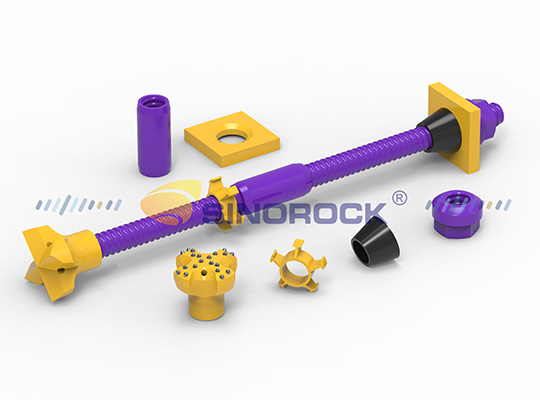Corrosion mechanism and protection method of rock bolt
Time:2020-11-25From:sinorock View:
Rock bolting support is a very common support method, and most of the support material are steel. During supporting, it will inevitably be corroded when buried in the rock layer. So, understanding its corrosion mechanism and protection method is particularly important to the projects quality.
The corrosion formation of anchor bolt mainly includes chemical corrosion, electrochemical corrosion, high-stress corrosion and scattered current corrosion, of which electrochemical corrosion and scattered current corrosion are the main ways. This is mainly caused by the contact of corrosive media in groundwater and air with anchor bolt outer surface. It is necessary to prevent the water and air in the stratum or rock cracks from contacting with rock bolt.
Commonly isolation methods including grouting wrapping, epoxy coating or (and) galvanized, casing isolation, etc. The appropriate protection method is usually chosen according to project service life and geological corrosion situation.
The corrosion formation of anchor bolt mainly includes chemical corrosion, electrochemical corrosion, high-stress corrosion and scattered current corrosion, of which electrochemical corrosion and scattered current corrosion are the main ways. This is mainly caused by the contact of corrosive media in groundwater and air with anchor bolt outer surface. It is necessary to prevent the water and air in the stratum or rock cracks from contacting with rock bolt.
Commonly isolation methods including grouting wrapping, epoxy coating or (and) galvanized, casing isolation, etc. The appropriate protection method is usually chosen according to project service life and geological corrosion situation.

Non-protective products are available in temporary support works (< 2 years) or non-corrosive environments.
In semi-permanent support engineering (2-5 years), hot-dip galvanizing corrosion protection system or epoxy coating corrosion protection system can be used according to the corrosive environment.
In permanent support engineering (> 5 years) according to the corrosive environment can choose to use hot-dip galvanizing anti-corrosion system or duplex coating anti-corrosion system.
For extremely harsh marine environments, anchor bolts with multiple anti-corrosion layers can be used.
Multiple anti-corrosion anchor bolts have more than two protective measures, usually being galvanized, epoxy treated and then wrapped with cement slurry. For more demanding projects, rock bolt with galvanized and epoxy can also be put into PE plastic casing, and then inject cement slurry into the casing pipes and holes, multiple anticorrosive anchor bolts are formed after consolidation, which have better corrosion resistance.
In semi-permanent support engineering (2-5 years), hot-dip galvanizing corrosion protection system or epoxy coating corrosion protection system can be used according to the corrosive environment.
In permanent support engineering (> 5 years) according to the corrosive environment can choose to use hot-dip galvanizing anti-corrosion system or duplex coating anti-corrosion system.
For extremely harsh marine environments, anchor bolts with multiple anti-corrosion layers can be used.
Multiple anti-corrosion anchor bolts have more than two protective measures, usually being galvanized, epoxy treated and then wrapped with cement slurry. For more demanding projects, rock bolt with galvanized and epoxy can also be put into PE plastic casing, and then inject cement slurry into the casing pipes and holes, multiple anticorrosive anchor bolts are formed after consolidation, which have better corrosion resistance.
latest news
-

- What Are the Applications of SDA Bolts in Hydropower Stations?
- Time:2025-08-21From:This Site
- Learn how self-drilling anchor bolts enhance slope stability, tunnel support, and dam reinforcement in complex geological conditions at hydropower stations. Optimize hydropower projects with efficient, cost-effective, and eco-friendly solutions.
- View details
-

- Slope Stabilization with SDA Bolts: Benefits & Applications
- Time:2025-08-19From:This Site
- Discover how self-drilling anchor bolts (SDA bolts) provide superior slope stabilization for highways, railways, and tunnels. Learn their key benefits, installation process, and real-world applications in loose or collapsible soils.
- View details
-

- How Self-Drilling Rock Bolts Enhance Tunnel Support in Fractured Rock?
- Time:2025-08-15From:This Site
- Discover how self-drilling rock bolts enhance tunnel support in fractured rock. Learn their benefits, installation steps, and real-world applications for safe, efficient tunneling.
- View details
-

- Sinorock 2025 Quality Month | Strengthening Quality Foundations, Empowering Product Excellence
- Time:2025-08-13From:This Site
- Sinorock’s 2025 Quality Month, themed “Strengthening Quality Foundations, Empowering Product Excellence,” successfully concluded, reinforcing our commitment to superior product quality.
- View details
-

- Sinorock Safety Month 2025 | Everyone Speaks Safety, Everyone Can Respond
- Time:2025-07-03From:This Site
- Sinorock Safety Month 2025, centered on the theme "Everyone Speaks Safety, Everyone Can Respond - Spot Workplace Hazards," has wrapped up successfully!
- View details
-

- Quality Control: the Vital Factor of A SDA Bolt Factory
- Time:2025-01-09From:This Site
- Sinorock’s comprehensive quality control system, from supplier management to outgoing inspections, ensuring the highest standards for self-drilling anchor bolts in construction.
- View details
-

- Sinorock Invites You to Explore Proven Self-Drilling Anchor Bolt Solutions at bauma 2025
- Time:2025-03-07From:This Site
- From April 7–13, 2025, explore Sinorock’s Self-drilling anchor bolt solution at Booth C2.513/4 in Hall C2 of the Messe München Exhibition Center (Munich, Germany).
- View details
-
.jpg)
- SINOROCK to Attend EXPOMINA PERÚ 2024 in Lima, Peru
- Time:2024-08-10From:This Site
- Sinorock to Attend EXPOMINA PERÚ 2024 in Lima, Peru
- View details
-
.jpg)
- SINOROCK to Participate in MINING AND METALS CENTRAL ASIA 2024
- Time:2024-08-08From:This Site
- SINOROCK to Participate in MINING AND METALS CENTRAL ASIA 2024
- View details
 Download
Download 


